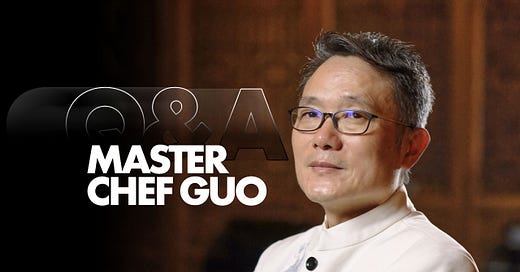Mastering the Art of Flavor: An Exclusive Interview with Chinese Master Chef Guo Wenjun, Pioneer of New Age Culinary Arts
Wild Green Stir Fried Rice
In the world of culinary maestros, few shine as brightly as Master Chef Guo Wenjun. With his whisk as his wand, Chef Guo crafts more than mere meals; he conjures up a symphony of flavors, steeped in tradition yet daringly innovative. Imagine a culinary journey that began in the humble kitchens of the Chinese royal lineage and meandered through the bustling streets of Hong Kong, only to redefine the very essence of modern gastronomy.
Chef Guo, the veritable "Pioneer of the New Age of Culinary Arts," blends the old with the new, creating a fusion that's not just a feast for the palate but a spectacle for the senses. In our exclusive interview, we unravel the tapestry of his illustrious career – a journey flavored with persistence, innovation, and a dash of secret ingredients that make his dishes not just food, but a celebration of life itself.
As a food journalist and a foodie, I've always believed that every chef has a story, a secret ingredient that makes their food transcend the ordinary. And with Chef Guo, you are about to uncover a tale woven with flavors, passion, and a relentless pursuit of culinary perfection. So, let’s embark on this gastronomic journey, exploring the insights and inspirations of a master who cooks not just with ingredients, but with his heart and soul.
Chef Guo, your journey from a young apprentice under Master Chef Ding Guangzhou to becoming a globally recognized master of Chinese cuisine is truly inspiring. Could you share with us the most pivotal moments in your early career that shaped your culinary philosophy?
In my twenties, I had a customer in the Shanxi Province who once ordered grade-eight abalone because he believed that the most expensive food materials were the best for him (abalone being one of the most expensive ingredients in China). I couldn't convince him otherwise, and at the same time, I was astonished by his beliefs. From that moment onward, I embarked on a journey to explore my own food and culinary system. I began studying and researching the functions and interactions between different ingredients, focusing on achieving a balance of taste and considering the color of the food.
According to Chinese traditional medicine theory, food and medicine share the same source. Motivated by this belief, I sought to enhance nutrition through the combination of multiple ingredients. This exploration eventually led to the development of my own culinary system, which I named the Healthy Royal Cuisine Culinary System. My initial intention was for this system to enable customers to enjoy food that is not only delicious, but also promotes health and nutrition.
Your culinary style is a unique blend of traditional Chinese techniques and modern innovations. How do you balance respecting the rich heritage of Chinese Imperial Cuisine while continuously pushing the boundaries of culinary art?
My culinary system is deeply rooted in my culture. However, adhering strictly to tradition cannot meet the demands of contemporary society and culinary concepts. Therefore, building upon the traditional Chinese cuisine standards of "Se, Xiang, Wei, Xing, Qi," meaning "Color, Smell, Taste, Presentation, and Tableware," I have evolved to establish my own set of standards, namely "Shang, Wen, Sheng, Yi, Yang” meaning "Modern, Temperature, Sound, Story, Nutrition."
Today, customers seek more than just satisfaction from the food itself. They also appreciate beautiful presentation on the plate, precise control of ingredient temperatures, harmonious music in the dining room, detailed explanations of each dish, compelling stories behind the menu, and well-thought-out combinations of ingredients to enhance nutritional value.
In your illustrious career, you’ve created your own category of healthy, royal Chinese cuisine. Can you elaborate on the process of developing this distinct style and how it reflects your personal culinary vision?
My mentor, Master Chef Ding Guangzhou (7th generation disciple in the ancient lineage of royal chefs), primarily focused on using expensive and rare food materials in his cooking. In my late twenties, I had the opportunity to learn Western cooking in Hong Kong. During this time, I also delved into nutrition science and traditional Chinese medicine.
The formal training, I received from my Shi-Fu (meaning mentor) laid the foundation for my culinary skills, while the knowledge gained from studying Western cuisine, modern nutrition science, and Chinese medicine contributed to my overall growth. Ultimately, these experiences led me to create my own culinary system. This system not only produces delicious meals, but also prioritizes health and nutrition.
Who or what are your biggest inspirations in the culinary world, and how have they influenced your approach to cooking and menu creation?
My father was a renowned local chef in my village, and during my childhood, he prepared some famous Chinese dishes for me. One of my favorites was Chinese baked carp, a dish that I later incorporated into the experience menu at Chef Guo restaurant. My father possessed the remarkable skill of crafting dishes from whatever ingredients were available to him. Cooking for friends and family brought him immense joy.
As I establish my own menu, my aspiration is to convey the same sense of enjoyment and connection to my customers.
Your restaurant, Chef Guo, offers an immersive experience in Chinese culture. What role do you believe the dining atmosphere plays in enhancing the culinary experience, and how do you achieve this at your restaurant?
The Chinese character "宴" represents "banquet." Breaking it down, "宀" signifies a house, and "妟" translates to "comfortable, leisure." I designed the dining room with this concept in this mind.
The interior is designed to transport diners to an imperial courtyard. The ornate, Zen dining room features a faux gingko tree, Chinese like the Chinese Bian Zhong (Bronze Chime Bell), an ancient instrument from 2500 years ago, stone horse pillars standing the entrance to welcome guests, and white glove service to complete the experience. The dimly lit intimate dining room softly plays Chinese classical music allowing diners to focus on the intricate dishes before them without distraction.
Diners arrive at their table to find an elegant hand painted charger plates covered by 24-karat gold accented porcelain serving cloches. The carefully selected music, thoughtfully designed lighting, servers adorned in traditional Long Pao (Dragon Robe) representing each dish to our guests—all of these elements come together to create a unique ambiance for our dining experience.
You have been lauded for your revolutionary culinary presentation philosophy. Could you share your thoughts on the importance of presentation in high cuisine and how it contributes to the overall dining experience?
In today's society, the only constant is the inevitability of change itself. Technology undergoes rapid transformations, with significant shifts in cell phones and social media, necessitating corresponding changes in the culinary experience. Particularly for younger generations, the presentation has assumed an increasingly crucial role in fine dining. Food is now appreciated not just for its taste, but also as a visual delight; indeed, the eyes savor the dish before the palate does. To preserve the authenticity of our true Chinese cuisine, presentation takes precedence in shaping the overall culinary experience.
Having received numerous awards and served dignitaries from around the world, what challenges have you faced in maintaining such high standards, and what does this global recognition mean to you?
My greatest challenge lies in breaking through my own limitations, not merely maintaining high standards, but consistently surpassing them. I value the global recognition I have received as a part of my spiritual wealth. This recognition extends beyond just myself; it is also acknowledgment for my community and culture, which have nurtured both me and my culinary system. Simultaneously, it serves as a constant reminder to continually push the boundaries of culinary art.
Your new 10-course menu features the 'Eternal Bliss of QianKun Pot,' a dish with a rich historical background. Could you tell us more about the inspiration behind this dish and its significance in your menu?
As you are aware, one of the fundamental concepts in my culinary system is balance, encompassing not only the balance of taste but also of color, aroma, nutrition, and more. I wanted to create a dish that encompassed all of these features. After about two years, while sorting through my Master Ding Guangzhou, documents following his passing, I stumbled upon an ancient recipe from the Ming Dynasty, during the reign of Ming Cheng Zu (The Yongle Emperor) – Zhu Di.
He moved the capital to Beijing, considering it the Land of Dragon Rising and the center of the world. The Emperor tasked the Imperial Chef with celebrating a grand event using a dish. The concept of Qian Kun, vital in Feng Shui, caught my attention. It symbolizes the harmony of Heaven & Earth, Yang & Ying, Sun & Moon, Male & Female—in essence, the balance of nature. This discovery brought me immense joy as it aligned perfectly with what I had been seeking. After numerous experiments and refinements, it eventually evolved into the Eternal Bliss of QianKun Pot, serving as the signature course in the new 10-course experience.
What advice would you give to young chefs who aspire to achieve excellence in the culinary arts, especially in the realm of traditional cuisines?
I would emphasize "learning." Culinary work demands a lifelong commitment to staying current and continually improving. Engaging in communication with peers is equally crucial, as it facilitates learning from each other's strengths.
Please share your 'secret ingredient' - a personal or professional element that they believe sets them apart in the culinary world. Chef Guo, what is your 'secret ingredient’?
In our culture, there's an old saying: "Xue Wu Zhi Jing," which translates to "Life-long Learning." My "secret ingredient" is quite simple: consistently engage in learning, always explore new avenues, and never give up.
Finally, Chef Guo, if you were to describe your culinary journey and the essence of your cuisine in just three words, what would they be?
The three words I would select would be: “Endeavor, Proficient, and Breakthrough”.
Recipe from Master Chef Guo, For Chef & Rare
Wild Green Stir Fried Rice
Offered on Chef Guo’s new 10-course tasting menu
Ingredients:
Wild millet rice
Chinese chive juice
Chinese sweet rice
Wild mountain pepper (Chinese pepper)
Cooking oil of choice
For garnish: Chinese chive and edible flowers
Optional garnish: pork and Chinese sausage
Instructions:
Cook the wild millet rice, allow to cool slightly, then fluff with a fork.
Mix the wild millet rice with Chinese chive juice.
Stir fry the rice with wild mountain pepper, then remove from the heat and set to the side.
Ground the sweet rice into paste then shape into a ball. Fry in oil until golden brown.
Remove the rice ball from the oil and use chopsticks to open one side of the ball to create a bowl-like shape. Fill the resulting space with the stir fried wild green millet rice.
Garnish with chopped Chinese chives, and decorate with edible flowers. If you wish, you may sprinkle chopped pieces of pork and Chinese sausage atop the rice as well.
Serve and enjoy!












